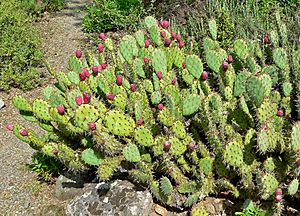Prickly pear facts for kids
Quick facts for kids Prickly pear |
|
|---|---|
 |
|
| Opuntia littoralis var. vaseyi | |
| Scientific classification |
|
| Kingdom: | Plantae |
| Clade: | Tracheophytes |
| Clade: | Angiosperms |
| Clade: | Eudicots |
| Order: | Caryophyllales |
| Family: | Cactaceae |
| Subfamily: | Opuntioideae |
| Tribe: | Opuntieae |
| Genus: | Opuntia Mill. |
| Species | |
|
Many, see text. |
|
| Synonyms | |
|
|
The prickly pear is a type of plant called Opuntia. It belongs to the cactus family, known as Cactaceae. There are about 190 different kinds, or species, of Opuntia plants.
Contents
What is Opuntia?
The name Opuntia comes from an Ancient Greek city called Opus. A long time ago, a writer named Theophrastus wrote about an edible plant there. This plant could grow new roots from its leaves.
Prickly Pears in Australia
How They Arrived
Prickly pears, mostly the Opuntia stricta type, were first brought to Australia in the 1700s. People planted them in their gardens. Later, they were used to make natural fences around farms.
Becoming a Problem
These plants grew very quickly and spread everywhere. They became an invasive weed. They turned a huge area of farmland, about 101,000 sq mi (260,000 km2), into a thick, green jungle. In some places, the prickly pear plants grew as tall as 20 ft (6.1 m)!
Fighting the Weed
In 1919, the Australian federal government created a special group. It was called the Commonwealth Prickly Pear Board. Their job was to work with state governments to get rid of the weed.
Early Solutions
At first, they tried to remove the plants by hand or with machines. They also used strong chemicals to kill them. But these methods did not work well.
A Natural Solution
As a last idea, they tried something called biological control. This means using a living thing to control a pest. They found a moth from South America called Cactoblastis cactorum. The larvae (baby moths) of this moth love to eat prickly pear.
The Moth's Success
The moth was brought to Australia in 1925. It quickly helped to reduce the number of cactus plants. There is even a special hall in Chinchilla, Queensland that remembers the moth. This was one of the first times that biological control was used to fight pests.

